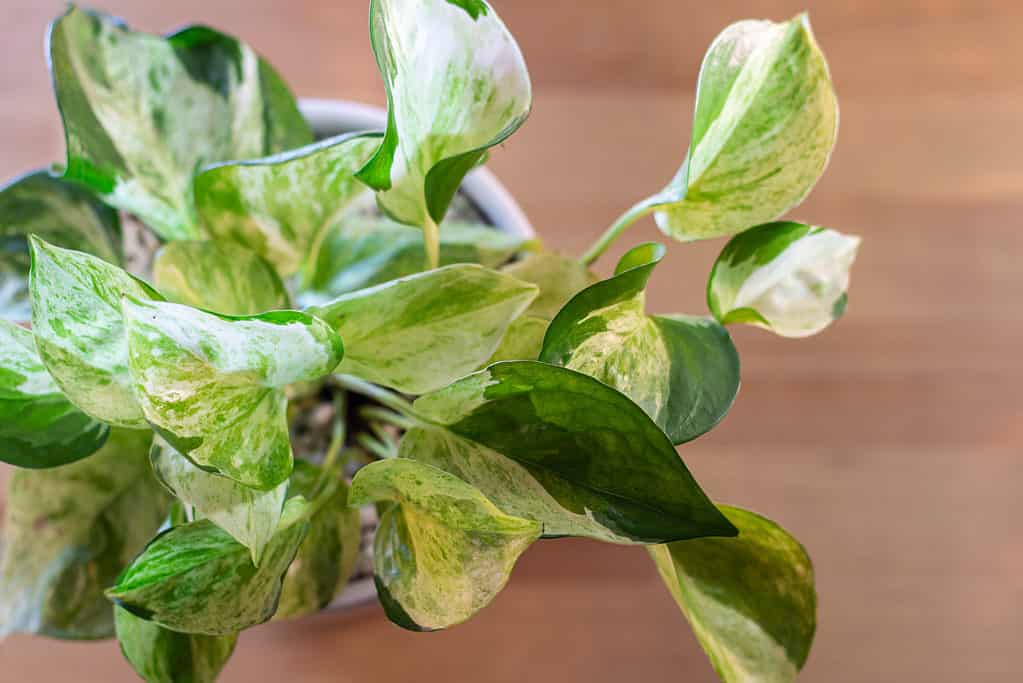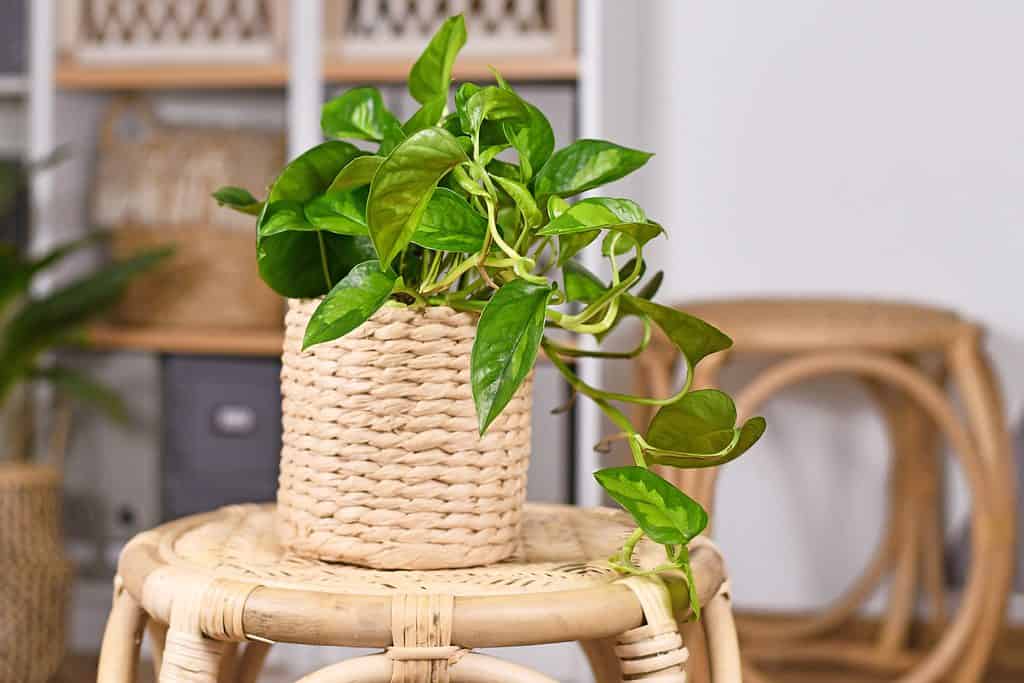If you’re a fan of collecting pothos plants, you may be interested in acquiring some rare, more difficult-to-find cultivars. While you can easily find over a dozen cultivars of this lovely tropical houseplant, a few are a bit trickier to get ahold of. If you’re an enthusiast of rare houseplants, this is the read for you!
In this guide, we’ll discuss the following three rare pothos cultivars:
- ‘Manjula’ Pothos
- ‘Global Green’ Pothos
- ‘Shangri La’ Pothos
Pothos: Classification, Native Origin, and Cultivation
Heat and humidity-loving, pothos is a tropical plant belonging to the Araceae botanical family. Pothos (Epipremnum aureum) thrives in filtered sunlight and fertile, well-draining, slightly acidic, and well-aerated soil.
This plant’s mature, outdoor version is quite different from the form it takes as a juvenile houseplant. In ideal tropical habitats, this lovely vine can grow up to 65 feet long. It will have stunning variegated leaves that grow up to 3 feet long. As a juvenile, the leaves of the native species are heart-shaped with smooth, entire margins. However, once this plant reaches maturity, the leaf becomes much more oval. You’ll notice prominent splitting along the margin that almost reaches the mid-rib.
Native to the Solomon Islands of the South Pacific, pothos has since spread to become naturalized in many tropical regions around the world. It’s now a widely popular houseplant, especially in North America. While many common cultivars of pothos are widely available, such as ‘Marble Queen’ and ‘Jade,’ rarer cultivars interest houseplant collectors. Below we’ll discuss three unique, rare, and lovely pothos cultivars.
What Makes a Pothos Cultivar Rare?
For pothos, patented cultivars are more often rare than non-patented types as the patent holder is the only individual or entity legally allowed to propagate, sell, or trade the cultivar unless the patent holder grants a license for propagation and distribution. The license holder then pays a fee to the patent holder in exchange for using the patented cultivar.
Suppose the patent holder does not propagate the cultivar in large amounts or grant licenses to other entities for that purpose. In that case, the specific plant will likely be challenging to acquire. The cultivars on this list are not usually found in your average big-box plant store in person or online. Instead, you may need to look at specialty plant suppliers to find what you’re looking for.
The rare status of these cultivars isn’t set in stone, however. As demand for specific cultivars increases, nurseries can sometimes adjust their supply if they have permission to propagate and distribute a patented plant. That’s why it can be helpful to call your local nursery and ask if they can begin selling a specific pothos cultivar you’re looking for.
3 Rare Pothos Cultivars
Horticulturists select or induce mutations for attractive leaf variegation or shape when developing a new pothos cultivar. Sometimes, cultivars result from a naturally occurring mutation that plant breeders then successfully propagate. Thankfully, for collectors of pothos, the rarity of the cultivar doesn’t usually entail a marked increase in plant care specificity. As such, beginner houseplant caretakers can generally dive right into acquiring these special pothos cultivars (as long as you can get your hands on them).
Any special plant care for rare pothos cultivars usually entails ensuring that variegated leaves don’t revert back to a monochromatic shade of green. Below, we’ll discuss three unique and rare cultivars that feature lovely leaf variegation and one that features an eye-catching leaf shape.
‘Manjula’ Pothos

‘Manjula’ is commonly referred to as the jewel of pothos.
©Catherine Tribone/Shutterstock.com
This gorgeous pothos cultivar originated in Mumbai, India, where plant breeder Dr. Ashish Arvind Hansoti discovered the plant as a naturally-occurring mutation of the non-patented ‘Marble Queen’ cultivar. Hansoti then successfully propagated the mutated plant through vegetative reproduction and patented the new cultivar as ‘Manjula’ with patent approval received in 2016. This striking plant is commonly referred to as the jewel of pothos.
‘Manjula’ is in high demand among collectors. Featuring highly variegated, wavy leaves with swirls, streaks, and splotches of cream, white, silver, and green. The variegation pattern is inconsistent across leaves, providing additional visual interest to this already stunning plant. A couple of common patterns exist, such as white, cream, and silver coloring centered more toward the middle of the leaf, with green bordering the margin. Another common variegation theme features leaves with a higher concentration of green on one side of the mid-rib, creating a split color effect.
Growth Habits and Plant Care Tips
Due to its high white, cream, and silver coloring, ‘Manjula’ pothos tends to grow a bit slower than other pothos cultivars with more green leaf coloring. This is because this cultivar has less chlorophyll, which gives plants their green pigment. For photosynthesizing plants, chlorophyll is necessary to convert light into energy. If a plant contains less chlorophyll, it will not grow as fast. Expect this cultivar to grow at a rate of about 4-8 inches per month. Make sure to grow this cultivar in bright, indirect light to maintain its high variegation coloring. If grown in too low of light, the plant will produce more green-pigmented chlorophyll in its leaves to compensate for the lack of light exposure.
‘Global Green’ Pothos

‘Global Green’ pothos provides colorful visual interest with bold yellow-green and dark green contrasts.
©Firn/Shutterstock.com
Plant breeder Hiroaki Asaoka first discovered ‘Global Green’ in 2016 in a Japanese nursery. Asaoka noticed the plant as the result of a naturally occurring mutation from a non-patented pothos cultivar. He successfully propagated the mutated plant via asexual reproduction, patented the result, and officially created ‘Global Green’.
Featuring green-on-green leaf variegation, ‘Global Green’ pothos provides colorful visual interest with bold yellow-green and dark green contrasts. Typically, the variegation pattern for this cultivar presents as the vivid, yellow-green coloring in the center and tip of the ovate-shaped leaf with the dark green surrounding. This cultivar is distinct for its notably pointy leaf tip.
Growth Habits and Plant Care Tips
Compared to other cultivars, ‘Global Green’ has particularly strong stems, dense foliage, and a wide spread. With its denser foliage and widespread, you can use this cultivar to fill in space among your collection or use it as a stand-alone statement piece. Grow in bright, indirect light to maintain the vivid yellow-green parts of its coloration.
‘Shangri La’ Pothos

‘Shangri La’ pothos features curled leaves that set it apart from all other pothos cultivars.
©sharohyip/Shutterstock.com
The unique Shangri La’ pothos is the final rare cultivar on our list. Developed in Japan by plant breeder Teruno Ito, ‘Shangri La’ pothos features curled leaves that set it apart from all other pothos cultivars. This unique curled-leaf growing habit gives this cultivar its nicknames of sleeping pothos and spinach pothos. Indeed, this cultivar provides a mystical, dreamy aesthetic to your collection with its half-awake leaves.
Leaf variegation can be rather unstable with this cultivar. Some plants develop yellow and cream variegation, while others tend to stay a more monochromatic dark green. As such, this cultivar is mostly purchased for its unique leaves.
Growing Habits and Plant Care Tips
Tending to grow a bit slow since its leaves don’t fully unfurl, expect this cultivar to grow at a rate of about 4-6 inches per month. Now, most variegated plants need bright light to maintain their colorful splotches, swirls, and stripes. However, too much light will cause the leaves of ‘Shangri La’ to unfurl, and you’ll lose the distinct characteristic of this rare cultivar. So, try to strike a balance by providing medium, indirect light but at a longer exposure time than other cultivars of 12-14 hours per day.
The photo featured at the top of this post is © Rezqiano/Shutterstock.com
Thank you for reading! Have some feedback for us? Contact the AZ Animals editorial team.






